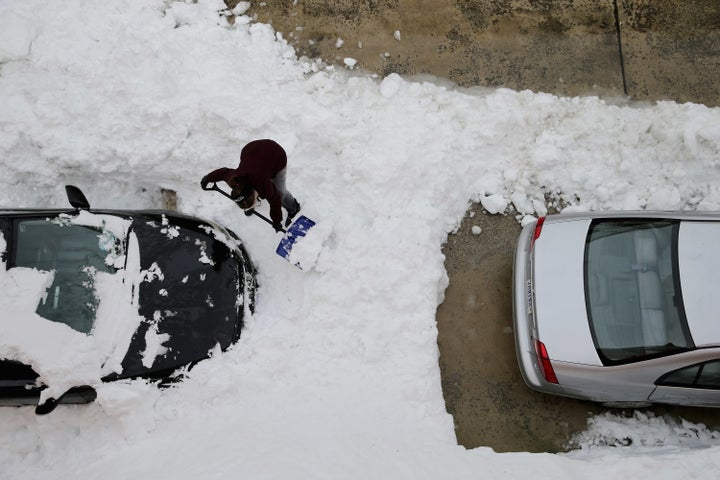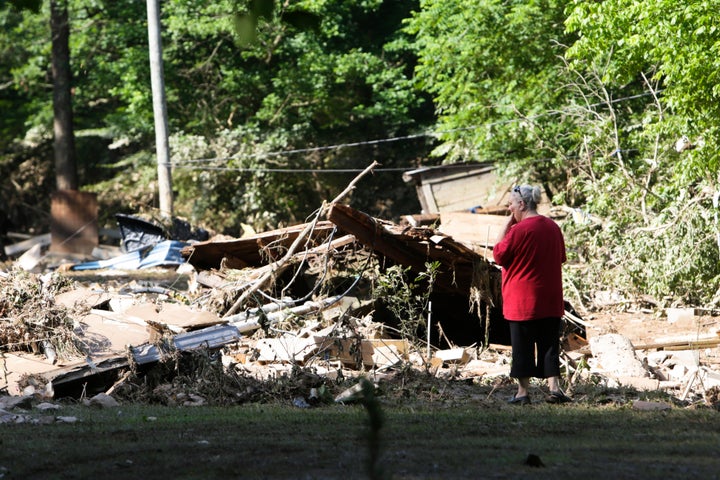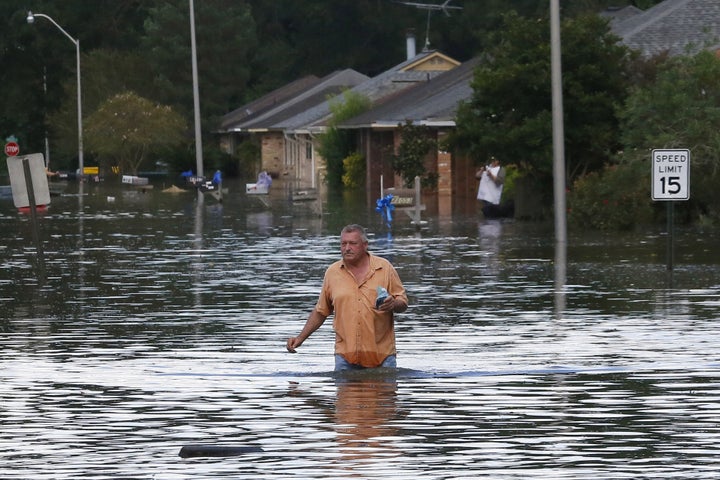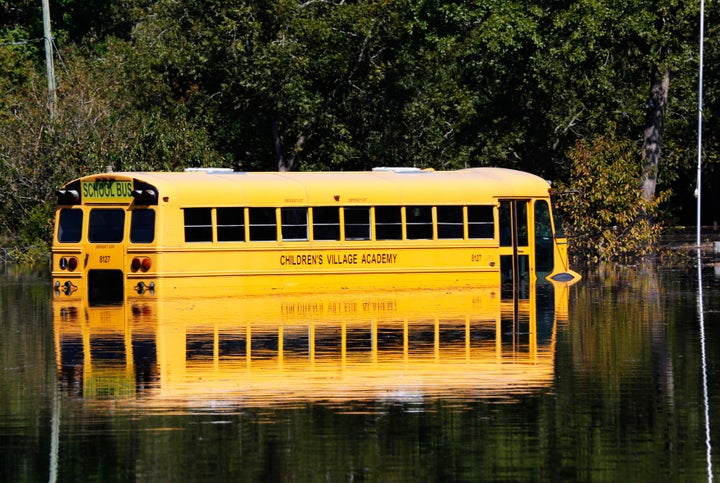The past year was scorching hot, freezing cold, soaking wet and consumed in flames ― and it’s just a sneak peek of what’s to come if we don’t change our course on energy, scientists say.
Some of climate change’s more dire potential effects ― cities submerged by rising sea levels, accelerated mass extinctions, a ruined global economy ― haven’t happened yet, at least not in a way that feels immediate to our daily lives. But more intense and more frequent extreme weather is a consequence we’re experiencing right now.
Here are some of the biggest climate events the U.S. experienced in 2016:
A massive blizzard battered the East
The year kicked off with a January blizzard that set multiple snowfall records in the East, covering about 434,000 square miles in 26 states.
The event was the all-time biggest snowstorm in at least six locations, The Weather Channel found ― Allentown, Pennsylvania, with 31.9 inches; Baltimore-Washington International Airport in Maryland with 29.2 inches; Harrisburg, Pennsylvania, with 30.2 inches; New York City’s Central Park with 27.5 inches; New York’s LaGuardia Airport with 27.9 inches; and New York’s JFK Airport with 30.5 inches.

It fell just short of setting records in Washington, D.C., and Philadelphia.
The blizzard, which The Weather Channel gave the unofficial nickname “Jonas,” claimed at least 50 lives and affected more than 100 million people.
The storm’s massive yield may have been the result of climate change driving shifts in the jet stream, which research shows can lead to weather systems slowing down and lingering in one place for longer, allowing them more time to drop snow on a given area.
We experienced the summer of floods
Summer 2016 saw not one, but three “1-in-1,000-year floods,” a meteorological term used to describe floods that have only a 0.1 percent chance of occurring. The deadly incidents in West Virginia, Maryland and Louisiana hit in quick succession and accounted for a full one-third of such floods in the U.S. since 2010, according to USA Today’s count.
The wet summer was part of an alarming pattern. According to the National Climate Assessment, the frequency and strength of intense downpours in the U.S. has gone up over the past three to five decades. The trend is particularly notable in the Midwest and Northeast, which since 1991 have experienced 30 percent more rainfall than the 1901-1960 average.
The higher temperatures across the U.S. and the rest of the world are allowing the atmosphere to hold more moisture, scientists say, giving what might have been routine storms a powerful boost.
The consequences of this summer’s downpours were staggering.
Flooding in West Virginia in late June killed at least 24 people and damaged more than 5,000 homes, making it the worst flooding event to hit the state in a century.

“Normally tranquil rivers turned into a violent mash-up of water and whatever else had washed into the streams,” the National Oceanic and Atmospheric Administration reported. “In addition to the terrible loss of life, property damage was enormous: bridges and roads washed out, houses destroyed, whole towns inundated.”
Just a month later, another 1-in-1,000-year flood hit Maryland, killing two people.
“The deaths and damage caused by this weekend’s flash flood in Ellicott City, as well as the damage caused elsewhere, remind us that climate change is about more than polar bears and the rising sea level in the Chesapeake Bay,” Maryland state Sen. James Rosapepe (D) told The Baltimore Sun at the time.
“Normally tranquil rivers turned into a violent mash-up of water and whatever else had washed into the streams.”
- The National Oceanic and Atmospheric Administration on the West Virginia floods
Finally, downpours that pummeled Louisiana in mid-August created the worst natural disaster to hit the U.S. since Hurricane Sandy in 2012, aid groups declared. The resulting floods killed 13 people, forced 30,000 citizens to evacuate and damaged at least 60,000 homes.
“I’ve never seen so many traumatizing things in such a short period of time,” Gerald Burkins, one of the Louisianians who lost everything in the flood, told The Huffington Post at the time.

Arkansas, Mississippi, Tennessee and Texas also experienced major flooding events between March and the end of summer.
Hurricane Matthew set unusual records
In October, Hurricane Matthew shattered records as one of the longest-lasting, strongest hurricanes of its kind and left a massive death toll in its wake.
Before Matthew struck the U.S. and claimed 46 lives in North Carolina, Florida, South Carolina, Georgia and Virginia, it pummeled Haiti, killing more than 1,000 people there.
“The nearly unprecedented rapid intensification we saw with this storm is favored by warmer oceans and greater ocean heat content,” Michael Mann, a leading climate scientist and professor of meteorology at Pennsylvania State University, told HuffPost at the time.

A hurricane of Matthew’s force striking in October demonstrated the power of climate change to turn seasonal disasters into year-round threats. While hurricane season in the Atlantic runs from the beginning of June to the end of November, the statistical peak is Sept. 10, when ocean temperatures are high. But climate change is driving up temperatures during months that aren’t typically warm enough to support strong storms, and hurricane season is beginning to last longer.
Matthew lasted more days in October than any Category 4-5 hurricane on record, meteorologists noted. It was also the longest-lasting Category 4-5 hurricane in the eastern Caribbean.
The Weather Channel documented a number of other records set by Matthew regarding its unusual location, strength and timing: It was the southernmost Category 5 in the Atlantic Basin, the first Category 4 landfall in Haiti in 52 years and the longest-lasting Category 3+ hurricane to form after Sept. 25 in any year on record.
Record-breaking heat gave us a glimpse into the future
With 2016 poised to be the hottest year on record, sweltering heat waves throughout the summer gave Americans a taste of what’s to come if temperatures continue to rise.
“If we continue with business-as-usual burning of fossil fuels, by mid-century what we think of as extreme summer heat today will become a typical summer day,” Mann, the Penn State professor, told HuffPost over the summer.
The Southwest suffered through unprecedented, triple-digit degrees early in the season. In Arizona on June 19, the heat set records for that calendar day in Yuma at 120 degrees, Phoenix at 118, Tucson at 115 and Flagstaff at 93, NOAA spokeswoman Maureen O’Leary told HuffPost. Tucson’s heat that day tied for the third hottest ever recorded in the city.
“If we continue with business-as-usual burning of fossil fuels, by mid-century what we think of as extreme summer heat today will become a typical summer day.”
- Climate scientist Michael Mann
Later in July, temperatures in the mid-to-high 90s scorched the New York tri-state area, Philadelphia, Boston, D.C. and beyond.
Philadelphia suffered multiple heat waves throughout the summer, with one in August killing four people. There were 15 90-plus days in the city in August, while a typical August experiences just five, The Philadelphia Inquirer reported. The city set another heat record the following month when temperatures remained above 80 degrees from midnight to midnight for the only September day on record, the local NBC affiliate reported.
Alaska also saw some of its highest temperatures in 2016. In July, the Arctic Coast community Deadhorse reached an all-time record high of 85 degrees. It was an especially notable record, climatologist Brian Brettschneider tweeted, because of its proximity to the Arctic Ocean.
It was warmer in Alaska at that time than it was in New York City, which measured a high of 82 that day, Mashable reported.
Wildfires raged in California and Tennessee
With ongoing drought and high temperatures drying up California’s forests and priming them for massive blazes, 2016 was another destructive wildfire season for the state.
In the first seven months of 2016, twice as many acres burned in the state than had burned in the same period the year before, the California Department of Forestry and Fire Protection told the Los Angeles Times.
The massive Soberanes fire that burned 132,127 acres near Big Sur for three months until October may have been the most expensive fire to fight in U.S. history, costing over $200 million to battle, The Associated Press reported based on data released by the National Interagency Fire Center.
The Erskine fire in Kern County in June burned more than 46,000 acres, affected nearly 400 structures, claimed two lives and ranks as the 15th most destructive in state history. Two fires from 2015, the Valley fire and the Butte fire, rank more damaging at third and seventh place, respectively.

More recently, a wildfire in Tennessee last month ranked as the largest fire in the state in 100 years. The massive blaze around Gatlinburg killed 14 people, forced 14,000 to evacuate, affected more than 2,400 structures and caused over $500 million in damages.
With a record hot autumn, a shortage of tropical storms and lots of wind, The Washington Post reported, a destructive conflagration was destined to descend from the Great Smoky Mountains into a nearby town. In the end, though, destiny may have had a helping hand: Police have charged two juveniles with aggravated arson in connection with the blaze.
